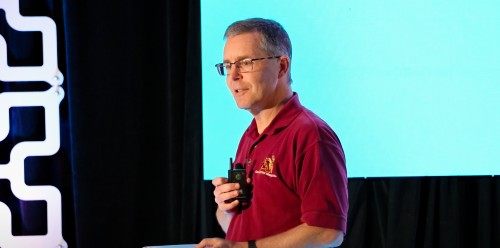Implementing a new full-suite, cloud-hosted Integrated Workplace Management System (IWMS) can be like a fairy tale or it can be a comedy of errors, according to Brian Swanson, Assistant VP of Finance & Systems at the University of Minnesota (UMN). When UMN put in new processes, they were shooting for something like The Neverending Story, but it didn’t go exactly as planned.
“If any of you remember this movie from the 1980s, it apparently involves sailing to the sky joyously on a magic flying puppy — that is not the story you are going to be hearing,” said Swanson, showing the whimsical movie poster on the screen. “Ours is much more of a different 1980’s movie — National Lampoon’s Vacation. Just about anything that could go wrong, did.”
What began as a 24-month “Out of the Box” implementation evolved into over a 48-month “Anything But Out of the Box” journey, and Swanson wants to help others avoid the mistakes they made along the way.
UMN Begins the Long Process of Updating
Swanson told the audience at HEFF that the Finance & Systems department supports a diverse range of operation groups at UMN, covering:
- 5 Campuses
- 20 Research and Field Stations
- 30 million gross square feet
- 30,000 acres
- 1,000+ leases
- 900+ buildings
He said that at one time they even had their own train and a mine.
“We’ve got one of just about everything except a casino,” he said. “We’re old, we’re big, we’re complex, geographically dispersed, and underfunded — so, your ideal maintenance profile.”
“What started out as a 24-month implementation became a 48-month implementation.”
A legislative audit showed that they needed to replace their maintenance management system, which encompassed many processes including facilities management, inventory, utility billing tools, capital projects, and the time and attendance system, among others.
Before the onset of the project, different departments didn’t communicate or even use the same terminology, so UMN decided to bring in an IT solution to unify what had become a “Tower of Babel.” Finding an all-in-one application was a challenge, to put it mildly, but implementing the software update they chose was even harder.
UMN Hired Consultants, But Did That Help?
UMN intended it to be more than a software system upgrade, but also a business process improvement activity to change how they operated. They spent roughly $1 million for consultants to help guide the process, but realized that was maybe not money well spent.
“The consultants advised us, at that stage, to dream big,” Swanson said. “‘Don’t be limited by what the software can do, think about what your best practices should be, how you want to do this, what the optimal world is,’ which is what we did. We spent a lot of money, countless staff hours, and I would say — that was bad advice.”
Swanson explained how they undertook the challenge, initially, with four guiding parameters:
- Use one tool that does it all, like a Swiss army knife
- All 5 campuses and 20 research stations are “going to hug” and do things the same way
- Go completely out of the box and buy a piece of software, then just use it as it is
- Do all of this as a cloud software service system
“And you can see, already, how we’re setting ourselves up for a bit of trouble as we move down the path,” he said. “Individually, they’re all sort of best practice decisions, but when you add them all up…”
Not only did implementation take twice as long as originally scheduled, but they also underestimated some of the additional changes required.
Instead of rolling out changes slowly, they decided to do them all at once and estimated it would take two years. They chose one Request for Proposal (RFP) to get software and implementation in one package for a single point of accountability.
“And that all sounds really good, except what we left ourselves with was zero degrees of freedom on moving anything after we actually got into this effort and learned what was involved in the process.”
They hadn’t even picked the software at that point, but ultimately chose TRIRIGA, and quickly realized it wouldn’t work “out of the box” — changes and customizations needed to be made. Not only did implementation take twice as long as originally scheduled, but they also underestimated some of the additional changes required.

“What started out as a 24-month implementation became a 48-month implementation,” Swanson said.
“We had originally planned for five integrations, but that became 31 integrations. We had to build 82 data migration templates and we moved 5 million rows of data out of old systems into the new system and still had 5,000 hours of hand-entered, manual data entry where we hired students to just key data from the old system into the new system because you couldn’t actually get all these systems to automatically migrate the data.”
The Takeaway Lessons from UMN
UNM learned some valuable lessons from the experience:
- Think twice about “Best of Suite” solutions: Most are built for corporations, not education institutions
- Pick your components independently: Software, hosting, and implementation
- Match the business to the software rather than software to the business (or prepare to pay)
- A “System Architect” is essential
- Be wary of a “Big Bang” (all at once) implementation: It’s hard to change how you come out of the gate
- Plan early for integrations: Fewer developers and more integration specialists
- Start with a big contingency: UMN ’s integration was saved by a big contingency, and they still came in under-budget
“That is, in 20 minutes, a very abbreviated version of a seven-year trip.”
Posted by
Join us at HEFF!
An interactive retreat for facilities leaders at the nation's top colleges and universities.
Nov 8-10, 2026 | San Antonio, TX
Learn More









Comments